Bugatti
|
1939 - 1952 |
Country: |
 |
|
Ettore Bugatti
There was a time when Bugatti were arguably one of the most famous sports-car manufacturers in the world. The cars were aesthetically magnificent, if sometimes technically backward, and all were the work of Ettore Bugatti himself.
Naturally Ettore was born in Italy, and in 1900 at the somewhat tender age of 19 he would design his very first. Later he was responsible for the layout of several other cars not bearing his name, before he started up his own company at Molsheim, near Strasbourg, now in France, in 1909.
The earliest Bugattis may have used small, relatively hard-working engines, however their precision manufacture was immediately evident and stands as tribute to the founders continual quest for excellence. Prior to World War 1 Bugatti manufactured the “Type 13”, powered by a small but relatively powerful 1327cc engine. More popular, and much larger, the chain-driven 'Garros' model enjoyed success in sales and competition.
The Bugatti Type 13 Brescia
But it was after the war that Bugatti developed some truly sporting cars, among them the highly acclaimed “Type 13 Brescia” models - so named because cars of this type took the first four places in the Italian GP supporting race, at Brescia, in 1921.
Evolution of the Brescia included various derivatives with. engines between 1368 and 1496cc, the most powerful of all having being an overhead camshaft 16-valve four-cylinder engine. Good for up to 40bhp, this was sufficient to propel the lightweight (1350lb) racing versions at up to 100mph. Longer wheelbase touring models (the Types 22 and 23), could maintain 70mph with only a meager 30bhp on tap.
The Brescia’s would enjoy victory at the Le Mans Voiturette race in 1920, and followed this up with many impressive victories all over Europe. Even in Britain, where hill-climbs were finding immense popularity with the public, Raymond Mays would always be able to put in a good performances in his Brescia.
Built by Rabag in Germany, Diatto in Italy and Crossley in England
The cars would continue to be manufactured until 1926, with around 2000 being assembled at Molsheirn, though variants were also built by Rabag in Germany, Diatto in Italy and Crossley in England. In 1924, Bugatti produced the famous Type 35, a car that would achieve some 2000 competition victories in its production life of seven years. There were several sub-derivatives of the Type 35, with engines ranging in capacity from 1100cc to 2300cc, and body work built to sports or purpose built racing car specifications.
 The earliest Bugattis may have used small, relatively hard-working engines, however their precision manufacture was immediately evident and stands as tribute to the founders continual quest for excellence.
The earliest Bugattis may have used small, relatively hard-working engines, however their precision manufacture was immediately evident and stands as tribute to the founders continual quest for excellence.
 Prior to World War 1 Bugatti manufactured the “Type 13”, powered by a small but relatively powerful 1327cc engine.
Prior to World War 1 Bugatti manufactured the “Type 13”, powered by a small but relatively powerful 1327cc engine.
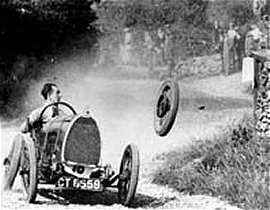 In the short time between 1925 and 1926 Bugatti cars would score an astonishing 1045 different racing event victories. Obviously this car was not amoung the winners.
In the short time between 1925 and 1926 Bugatti cars would score an astonishing 1045 different racing event victories. Obviously this car was not amoung the winners.
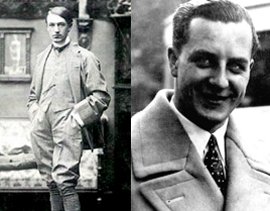 Jean Bugatti (right) bore a close resemblance to the young Ettore.
Jean Bugatti (right) bore a close resemblance to the young Ettore.
 The Bugatti Type 35C featured a wonderful straight-eight engine. In fact, Bugatti would only build either 4 or 8 cylinder cars, never a 6.
The Bugatti Type 35C featured a wonderful straight-eight engine. In fact, Bugatti would only build either 4 or 8 cylinder cars, never a 6.
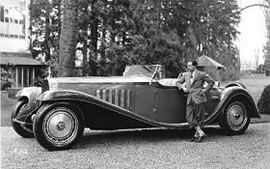 Tragically, Jean Bugatti would be killed in 1939 while testing one of the factory Type 41 Royale's around Molsheim. But just get a load of the size of that thing.
Tragically, Jean Bugatti would be killed in 1939 while testing one of the factory Type 41 Royale's around Molsheim. But just get a load of the size of that thing.
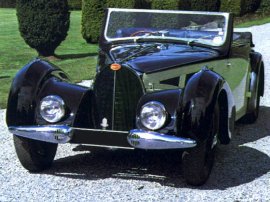 The most sporting of all was the short-chassis, lowered Type 57S, and its supercharged version, the 200bhp Type 57SC, though only about 40 of these two derivatives, from a total Type 57 output of 750 cars, were manufactured.
The most sporting of all was the short-chassis, lowered Type 57S, and its supercharged version, the 200bhp Type 57SC, though only about 40 of these two derivatives, from a total Type 57 output of 750 cars, were manufactured.
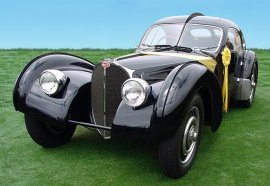 The Type 57SC backed up its looks with racing vicories, such as the 1936 French Grand Prix and the Le Mans 24 Hour races of 1937 and 1939.
The Type 57SC backed up its looks with racing vicories, such as the 1936 French Grand Prix and the Le Mans 24 Hour races of 1937 and 1939.
 Bugatti in name only, the EB110 had much more in common with the likes of Ferrari and Lamborghini.
Bugatti in name only, the EB110 had much more in common with the likes of Ferrari and Lamborghini. |
The Type 35, like the earlier Type 30 of 1922, used a straight-eight cylinder engine, originally of 2 litres and good for 90bhp. It is interesting to note that Bugatti made the leap from 4 cylinders to straight-8 cylinder engines without ever developing a mid-range 6 cylinder unit. Later there were 2.3-litre Type 35Ts (the T designating “
Targa Florio”), and various
Grand Prix types, including the supercharged Type 35Bs and 35Cs.
The Straight-Eight Masterpiece
The straight-eight engine was a masterpiece, both in its appearance and in its function. Two separate four-cylinder aluminium blocks were fixed to a common crankcase, all fits and finish being such that gaskets were not required. The crankshaft ran in five ball (or roller) bearings. A Type 35 weighed about 1650 lb, and racing versions were dominant in GP racing for several years. Most 'touring' versions were Type 35As, which looked like the GP racing derivatives, but had a less-complicated three-ball-bearing crankshaft engine from the Type 38.
These cars were good for a top speed of around 90mph (145 km/h), though competition types were capable of well over 100mph (160.9 km/h), and a 35B was clocked at almost 125mph (201 km/h) in 1930. Bugatti followed the success of the Type 35’s with the less loved Type 37, a car that effectively replaced the Brescia. The 37 was fitted with a 1496cc engine similar in design to the straight-eight, all in the chassis and
bodywork of the familiar Type 35.
The Bugatti Type 37
Critics naturally compared this 37 un-favorably with the Type 35; the touring version of the design, the Type 40, received an even less favorable reception. Both models were capable of 70mph (112.6 km/h) and were far less temperamental than the 'eights', but they never attained the God-like status of the Type 35’s. In total, some 290 Type 37s and 840 Type 40s were builtin a five-year production span.
It may have taken 5 years, but Bugatti realized the allure of their marque was being lost, and so in 1927 they released the new Type 43, which now used the 2.3-litre supercharged straight-eight engine lifted from the Type 35B racing car. Often called a 'Grand Sport' model, it could reach 90mph (145 km/h) from rest in 30 seconds and was good for a top speed of around 105mph (169 km/h). More than capable on the rally circuit, where it enjoyed much success, the car did not inspire the buying public and only 160 were sold over a five year period.
Keen to turn their fortunes around, the Type 43 was replaced by the Type 55 in 1932. The 2.3 litre straight-eight engine now featured a twin overhead camshaft and was good for a very healthy 135bhp. It had a top speed of around 112mph (180 km/h) and, although it was available in a range of different body styles, only 38 cars of the type were ever built.
Bugatti Production Cars
While focus may have been on the sports-car, Bugatti realized the need to manufacture more refined touring cars if the factory was to remain viable. In fact the factory produced many high-speed touring cars, the most famous being the splendid 1934 3.3 litreeight-cylinder twin-cam (140bhp) Type 57.
Though inspired by Ettore, much of the detail work was carried out by his son Jean; the cars were sold in various distinctly different types covering a range of body styles. The most sporting of all was the short-chassis, lowered Type 57S, and its supercharged version, the 200bhp Type 57SC, though only about 40 of these two derivatives, from a total Type 57 output of 750 cars, were manufactured. The Type 57 would take out the 1936 French
Grand Prix and the Le Mans 24 Hour races of 1937 and 1939.
The Bugatti Type 41 Royale Roadster
Far and away the most famous Bugatti touring car was the “Type 41 Royale Roadster”, designed and styled in 1932 by Jean. Tragically, Jean Bugatti was killed in 1939 in a car accident while testing one of the factory cars around Molsheim. The Royale however went on to become one of the most memorable sports-luxury cars in history! The name “Royale” was given to help the car appeal to the rich and famous and among the few that could afford to buy the car was King Alphonso XIII of Spain.
Unquestionably the "Grandest" car ever made – it weighed in excess of 3 tons and was powered by a 13 litre straight-8 engine derived from an airplane. In fact, the engine was so strong that it was later converted for train use! The Germans would occupy the Bugatti factory during World War 2, and car production never seriously re-started after that.
A hand-full of cars were cobbled together from left over pre-war parts in an attempt to re-establish production but this was simply too little, too late. Ettore would die in 1947 and the marque would fade into obscurity until 1987, when Italian tycoon Romano Artioli purchased the Bugatti name and built a modernised factory in Modena.
Artioli’s masterpiece EB110 was a V12 supercar beast, but owed much of it’s inspiration to fellow Modena residents such as Ferrari, Lamborghini, Maserati and De Tomaso, and only in name was it a Bugatti.
Bugatti Prototypes:
- 1900 - 1901 Type 2
- 1903 Type 5
- 1908 Type 10 'Petit Pur Sang'
- 1925 Type 36
- 1929 Type 40
- 1929 Type 41
- 1929 - 1930 Type 45/47 and Type 56 (electric car)
- 1939 Type 64 (coupe)
- 1943/1947 Type 73C
Racing Cars:
- 1910 - 1914 Type 13/Type 15/17/22
- 1912 Type 16 'bebe'
- 1922 - 1926 Type 29 'Cigare'
- 1923 Type 32 'Tank Bugatti'
- 1924 - 1930 Type 35/35A/35B/35T/35C/37/39 'Grand Prix'
- 1927 - 1930 Type 52 (electric racer for children)
- 1936 - 1939 Type 57G 'Tank'
- 1937 - 1939 Type 50B
- 1931 - 1936 Type 53
- 1931 - 1936 Type 51/51A/54GP/59
- 1955 - 1956 Type 251
Road Cars:
- 1910 Bugatti Type 13
- 1912 - 1914 Type 18
- 1913 - 1914 Type 23/Brescia Tourer (roadster)
- 1922 - 1934 Type 30/38/40/43/44/49 (touring car)
- 1927 - 1933 Type 41 'Royale, Coupe Napoleon'
- 1929 - 1939 Type 46/50/50T (touring car)
- 1932 - 1935 Type 55 (roadster)
- 1934 - 1940 Type 57/57S/Type 57SC (touring car)
- 1951 - 1956 Type 101 (coupe)
- 1957 - 1962 Type 252 (2-seater sports convertible)
Bugatti Automobili SpA
Italian entrepreneur Romano Artioli acquired the famous Bugatti name in
1987, and established Bugatti Automobili SpA. The new company built a factory designed by the architect Giampaolo Benedini in Campogalliano, Italy, a town near Modena, home to other performance-car manufacturers De Tomaso, Ferrari, Pagani and Maserati. By
1989 the plans for the new Bugatti revival were presented by Paolo Stanzani and Marcello Gandini, famous designers of the Lamborghini Miura and Countach. The first completed car was labelled the Bugatti EB110 GT, advertised as the most technically advanced sports car ever produced.
From 1992 through 1994 famed racing car designer Mauro Forghieri was technical director. On 27 August 1993, through his holding company, ACBN Holdings S.A. of Luxembourg, Romano Artioli purchased the Lotus car company from General Motors. The acquisition brought together two of the greatest historical names in automotive racing, and plans were made for listing the company's shares on international stock exchanges. Bugatti also presented in 1993 the
prototype of a large saloon called the EB112.
By the time the EB110 came to market the North American and European economies were in recession, and operations ceased in September 1995. A model specific to the United States market called the "Bugatti America" was in the preparatory stages when the company closed. Bugatti's liquidators sold Lotus to Proton of Malaysia. In 1997 German manufacturer Dauer Racing bought the EB110 license and remaining parts stock to Bugatti in order to produce five more EB110 SS units, although they were greatly refined by Dauer. The factory was later sold to a furniture-making company, which also collapsed before they were able to move in, leaving the building unoccupied.
Perhaps the most famous Bugatti EB110 owner was racing driver Michael Schumacher, seven-time Formula One World Champion, who bought the EB110 in 1994 while racing for the Benetton team. In 2003 Schumacher sold the car which had been repaired after a severe crash the year he bought it to Modena Motorsport, a Ferrari service and race preparation garage in Germany.
Also see: Bugatti Car Reviews |
Lost Marques - Bugatti (USA Edition) 


